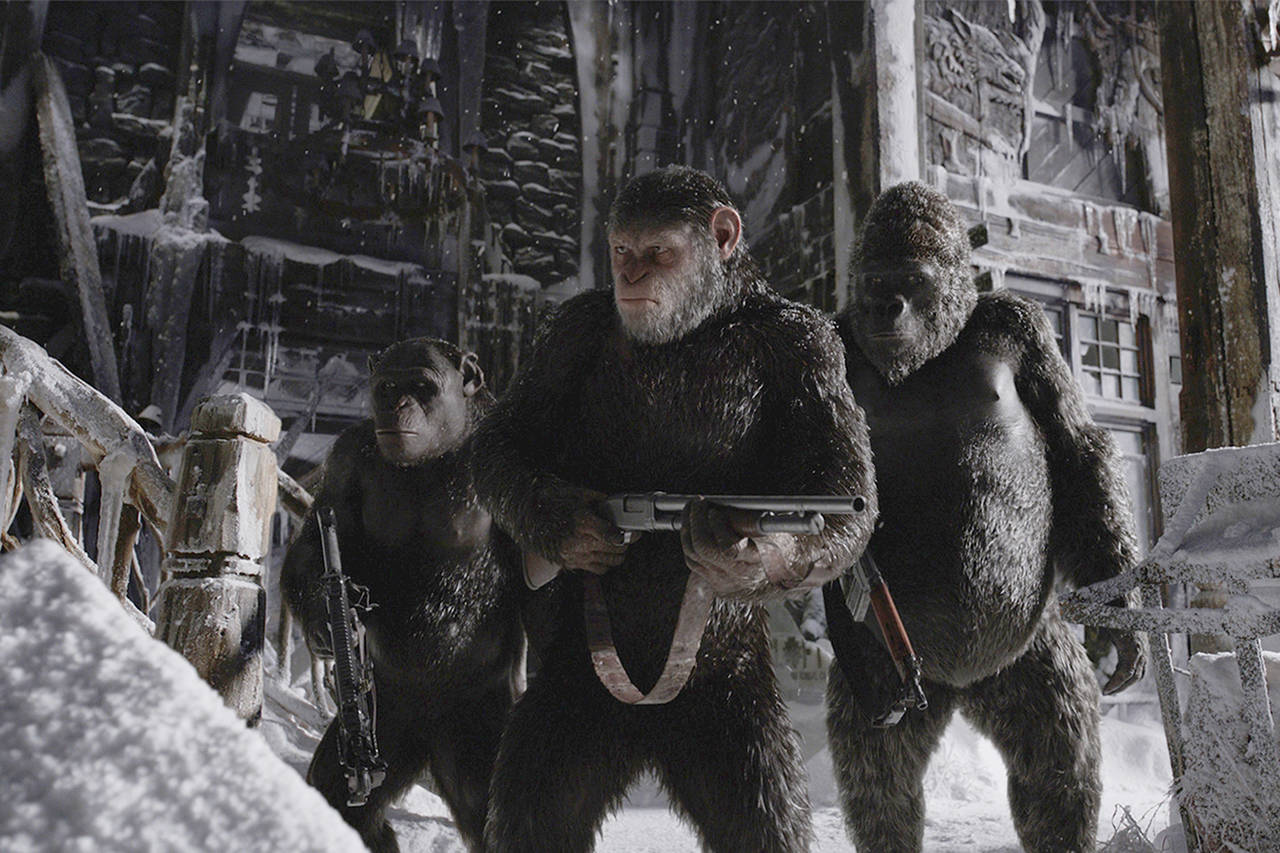By George Haerle
For The Daily World
It’s a real treat to see a movie like “War for the Planet of the Apes” in theaters.
What could have been a disaster of a reboot series in concept, the 21st century “Apes” saga has now brought an epic three-act story to fruition and finale. What began as a gripping first act in “Rise of the Planet of the Apes,” then brought the story to pulse-pounding stakes and a gripping catalyst in “Dawn of the Planet of the Apes,” “War” is truly the climax experience: a tragic, rousing, uplifting, vengeful last act of beast versus man — with a very thin line between the two.
The evolved apes of the previous films flee behind their chimpanzee leader, Caesar (Andy Serkis), when the last remnants of humanity determine them to be a threat after the events of “Dawn.” As an army of human remnants attempts to hunt them down, an act of war sends Caesar on a path of vengeance. The leader of the apes leads a crusade against the insane human colonel alongside his three lieutenants: Maurice the orangutan (Karin Konoval), Rocket the chimp (Terry Notary) and Luca the gorilla (Michael Adamthwaite).
Along their journey, they come across a mute girl (Amiah Miller), whose disability and later revealed name is connected to the original “Planet of the Apes,” and a strange chimp named Bad Ape who serves not only as a bit of needed comedic relief, but also as proof of something much bigger beyond Caesar and his tribe.
If Andy Serkis is not at least nominated for an Oscar for his performance as Caesar (as he should have been twice so far), this is truly a cruel and unjust world. What most people don’t realize is that throughout this “Apes” series, when you see Caesar on screen, you are looking at Serkis. Caesar is fully motion-captured. Highly sensitive and detail-oriented special effects trackers monitored the actor’s facial movements, twitches, eye movement, lips, walking, climbing, fighting, jumping, you name it. The appearance of him as an ape is just an incredibly detailed veil put over his body, voice and actions. Serkis’ performance, once again, will blow you away.
Speaking of special effects: Even if it weren’t for its excellent story, “War” would still be worth seeing purely on a technical level — more so than “Avatar” ever deserved. While “Apes” may not have the exotically alien planet of Pandora, the CGI effects in “War” outdo everything in James Cameron’s film by doing one thing oh-so right: You can’t tell the apes aren’t real. The CGI “skin” of Caesar and the other apes placed over the actors may be the most realistic and believable special effects put on screen to date. And because the effects are just so good and the animals are so believable, the story is made that much more rich and immersive.
Finally, there’s Woody Harrelson. While not featured as prominently as you’d think from the previews, he plays a radical military commander with a heart of darkness and a determined resolve that is clearly influenced by another famous, maddened colonel played decades ago by Marlon Brando. While Harrelson’s character is definitely more talkative and verbally coherent than Kurtz was in “Apocalypse Now,” his actions and ruthlessness create a mirror image — the man has clearly gone bananas. There’s even a fun reference to that Coppola classic that can’t be missed.
“War for the Planet of the Apes” is a must-see. But if you haven’t watched the other two films yet, you just might want to hold off on this one until you catch up. The series is truly a complete three-part experience, and this movie serves its greatest effect — and its ending is that much more gripping and final — if you get to know Caesar from his beginnings as a young chimp in “Rise” through his becoming a leader in “Dawn.”
In “War,” you’ll never want to see the human race lose so hard.
* * *
“War for the Planet of the Apes” is currently playing at the Riverside Cinemas, 1017 S. Boone St. in Aberdeen.
George Haerle holds a bachelor’s degree in creative writing for media and lives in Cosmopolis.



